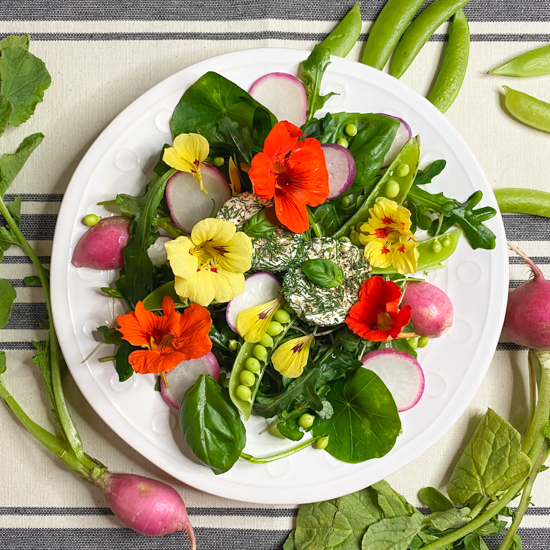Edible Nasturtium Salad
 Edible Nasturtium Salad
Edible Nasturtium Salad
With the mild peppery flavor of the flowers and greens in the pictured salad, a lightly sweet vinaigrette works well. Additional greens in the form of herbs coat the goat cheese rounds. Here is the full method I used to make the salad:
Mix a salad base, such as the arugula, microgreens, and home-grown basil in my version. Toss greens with a delicately sweet vinaigrette such as champagne, white wine, or even peach, and divide among plates. Cut rounds of goat cheese and roll in chopped fresh herbs such as dill and chives as well as freshly cracked black pepper. Top greens with the rounds. Slice radishes, sugar snap peas, and/or your favorite crunchy summer vegetable and intersperse. Scatter a handful of nasturtium blooms and leaves (see preparation and safety tips below). Drizzle with more vinaigrette.
Check to make sure a flower is edible before cooking with it. While nasturtiums, pansies, violets, borage, and many others can be used in cooking, some flowers can only be consumed in part, for instance the petals and not the leaves. If you have allergies to flowers and/or pollen, ask your doctor about safety. While a specific flower may be technically safe for consumption, it may not be a good choice based on your specific allergies. Always choose edible flowers grown organically without pesticides. If you find farm-grown flowers at the market, look for labeling that indicates they are safe to eat. For the safest growing environment and freshest blooms, try adding a few varieties to your home garden. As with herbs, their flavor is best when snipped right before use so keep an eye on buds about to show their gorgeous petals, which are the parts we want for our dishes. Even if flowers have been grown without pesticides, thoroughly wash them, then remove stamens and pistils. Follow any safety instructions for the variety with which you’ll be cooking and use only the edible parts.